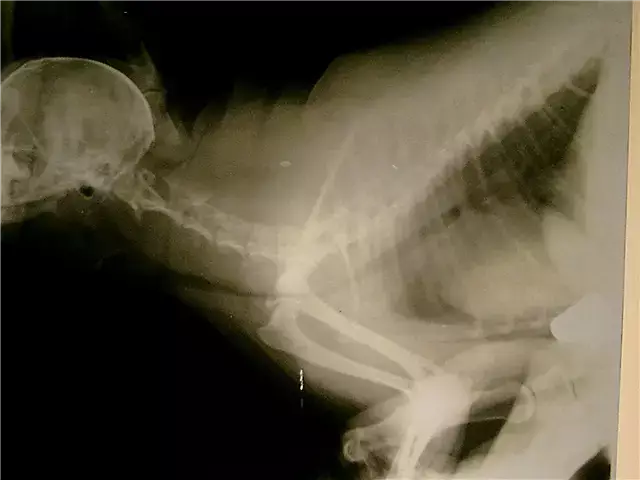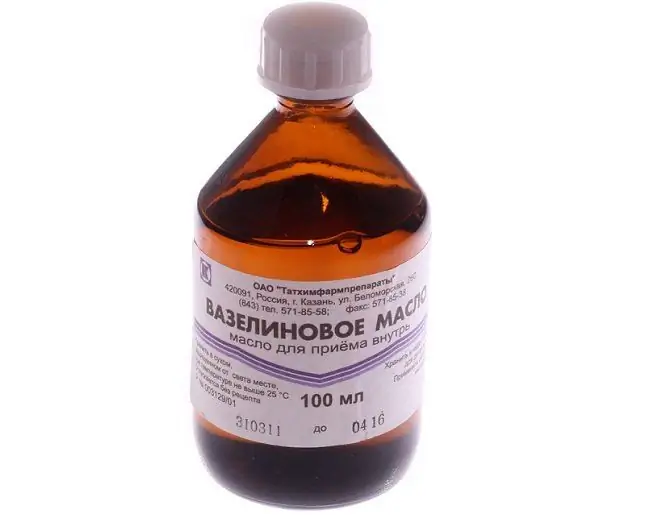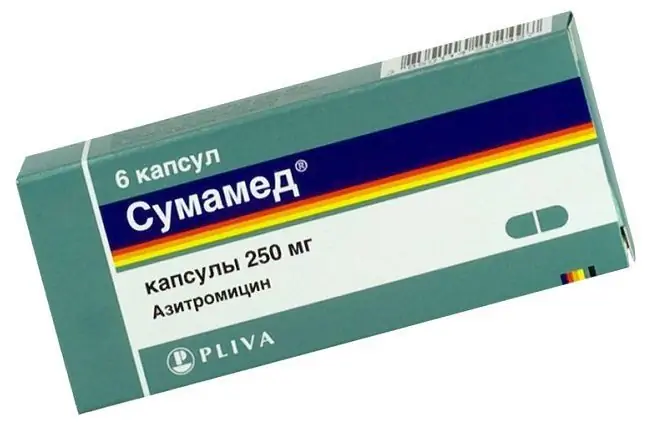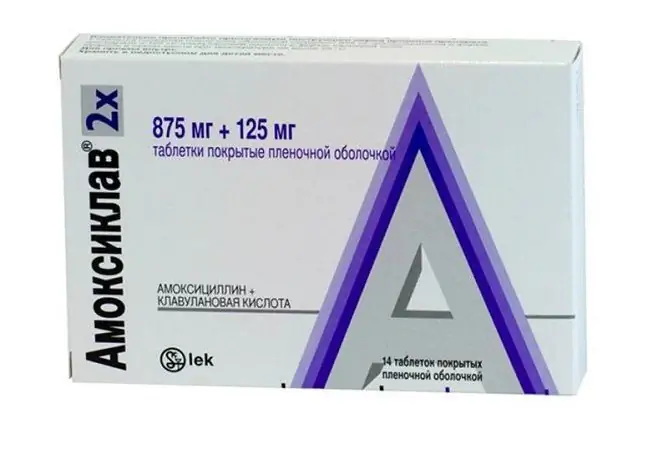- Author Rachel Wainwright [email protected].
- Public 2023-12-15 07:39.
- Last modified 2025-11-02 20:14.
Ambizom
Instructions for use:
- 1. Release form and composition
- 2. Indications for use
- 3. Contraindications
- 4. Method of application and dosage
- 5. Side effects
- 6. Special instructions
- 7. Analogs
- 8. Terms and conditions of storage

Ambizom is an antibiotic with antifungal action.
Release form and composition
Ambizom is released in the form of a powder and solution for infusion.
The active ingredient of the drug is liposomal amphotericin B.
Indications for use
According to the instructions, Ambiz is prescribed for:
- Cryptococcal meningitis;
- Disseminated cryptococcosis;
- Disseminated forms of candidiasis;
- North American blastomycosis;
- Phycomycosis;
- Histoplasmosis;
- Chronic mycetoma;
- Coccidioidomycosis;
- Hyalogyphomycosis;
- Visceral and American visceral cutaneous leishmaniasis;
- Systemic mycosis, manifested against the background of AIDS;
- Immunodeficiency caused by antitumor therapy.
The use of Ambizome is also indicated for patients with oncopathology complicated by neutropenia - to prevent the development of fungal infections and in patients who are prescribed a bone marrow or parenchymal organ transplant.
In accordance with the instructions, Ambizom is effective in febrile syndrome of unknown origin that persists after antibiotic therapy for 4 days, which has arisen in patients prone to developing fungal infections or patients with neutropenia.
Contraindications
The use of Ambizom is contraindicated simultaneously with the infusion of leukocyte mass, as well as in case of hypersensitivity to the active substance of the drug.
Ambizom, in combination with drugs that suppress tumor growth, can cause a decrease in blood pressure, bronchospasm and impaired renal function.
Method of administration and dosage
According to the instructions, Ambizom is injected intravenously over 30-60 minutes. For the treatment of systemic mycosis, 1 mg / kg / day is administered, increasing the dosage, if necessary, to 3 mg / kg / day.
Treatment lasts 2-4 weeks, during which time it is necessary to inject 1-3 g of the drug.
To prevent invasive fungal infection that occurs during transplantation of parenchymal organs, 1 mg / kg / day of the agent is administered for 5 days after surgery.
Patients with HIV infection complicated by disseminated cryptococcosis take 3 mg / kg / day for 6 weeks. After that, in some cases, to prevent the re-development of the infection, one more course of treatment is prescribed.
For the treatment of visceral leishmaniasis for 21 days, 1-1.5 mg / kg / day or 3 mg / kg / day Ambizoma is taken for 10 days. The same dosage is used for immunodeficiency.
Patients with neutropenia following chemotherapy or high-dose glucocorticosteroids should take 2 mg / kg / day. To eliminate a fever that does not respond to antibiotic therapy, Ambizom is prescribed at a dosage of 1-3 mg / kg until the normal temperature and neutrophil level are restored (up to 1,000 / μl).
For children, the drug can be prescribed in the same dosages calculated based on body weight.
Before use, Ambizom is dissolved in sterile water, which does not contain bacteriostatic additives, until a concentration of 4 mg / ml is reached. Thus, 1 bottle with 50 mg of the drug accounts for 12 ml of water. After adding the liquid, the vial is shaken until a homogeneous suspension is obtained.
Side effects
The use of Ambizom can cause the following side effects:
- Nausea;
- Vomiting;
- Increased activity of liver enzymes;
- Azotemia;
- Renal tubular acidosis;
- Chills;
- Rash on the skin;
- Breathing problems;
- Fever;
- Pain in the sternum and lower back;
- Anaphylactic shock;
- Hypokalemia;
- Hemolysis;
- Headache;
- Yellowing of the skin and sclera.
In addition, thrombophlebitis or phlebitis may develop at the injection site.
special instructions
Hypokalemia and pathology of the cardiovascular system is caused by the simultaneous administration of the drug with glucocorticosteroids, adrenocorticotropic hormones, carbonic anhydrase inhibitors.
The combination of Ambisome with hematotoxic drugs causes bone marrow depression.
In turn, the agent can increase the toxicity of cardiac glycosides, flucytosine, nephrotoxic drugs, muscle relaxants.
The drug is not combined with saline solutions (including physiological).
Solvents containing bacteriostatic additives can lead to precipitation.
Antifungal imidazole drugs cause resistance to amphotericin B.
Analogs
Ambizom analogs are:
- Amphoglucomin tablets;
- Amphotericin B and Amphocyl - in the form of lyophilisates;
- Ampholip in the form of a concentrate for the preparation of a solution for infusion.
Terms and conditions of storage
Ambizom should be stored in a dry place out of the reach of children, at temperatures up to 25 ° C. The diluted product can only be stored for a day, observing a certain temperature regime - 2-8 ° C.
The shelf life of the drug is 3 years.
Information about the drug is generalized, provided for informational purposes only and does not replace the official instructions. Self-medication is hazardous to health!






